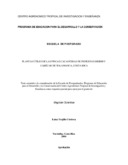Plantas útiles de las fincas cacaoteras de indígenas Bribrí y Cabécar de Talamanca, Costa Rica
Date
2004Author
Trujillo Córdova, Luisa
Autor Corporativo
CATIE - Centro Agronómico Tropical de Investigación y Enseñanza
Type
Tesis de maestría
Metadata
Show full item recordAlternative title
Useful plants in indigenous Bribri and Cábecar farms, Talamanca, Costa Rica
Description
Tesis (Mag.Sc.) - CATIE, Turrialba (Costa Rica), 2004
Abstract
El uso de las plantas domesticadas y silvestres para obtener alimento, medicinas, fibras, etc. es vital para las poblaciones Bribri y Cabécar de Talamanca, Costa Rica, quienes en sus fincas mantienen áreas cultivables, parches de bosque y pequeños bosques de galería. El uso, habitat, abundancia, fenología y manejo de las especies vegetales se estudió en ocho comunidades (5 Bribri, 3 Cabécar) con una metodología participativa. Se identificaron 282 especies vegetales que se utilizan como medicinal (104), comestible (103 especies), construcción (63), artesanal (55), combustible (42), comercial (28), tintes (7) y ornamental (6). Las mujeres mencionan especies alimenticias, ornamentales y tintóreas que crecen en patios, jardines y en campos agrícolas cercanos a las casas. Los hombres conocen más plantas del bosque y desconocen la mayoría de las especies ornamentales y tintóreas. Los Bribris utilizan más especies de artesanía que los Cabécares. The use of wild and domesticated plants as food, medicine, fiber, etc. is vital to Bribri and Cabécar indigenous farmers from Talamanca, Costa Rica, who retain in their farMON cultivated land, patches of forest and small gallery forests. The utilization, habitat, abundance, phenology and management of plant species was studied in eight communities (5 Bribri and 3 Cabécar) with the aid of a participatory methodology. A total of 283 useful species were recorded and classified as: medicinal (104), foof (103 species), building materials (63), handcrafting (55), firewood (42), cash crops (28), dyeing (7) and ornamental (6). Women listed species grown in patios and gardens, specially, species used for food, ornamental and dyeing. Men provided larger lists of forest species than women, but knew little about ornamental and dyeing species. Bribris use more species for handcrafting than Cabécares.
Keywords
BIODIVERSITY, HABITATS, BEHAVIOUR, BOTANICAL COMPOSITION, CROPS, FOOD CROPS, DRUG PLANTS, STRUCTURAL CROPS, ORNAMENTAL PLANTS, DYE PLANTS, ETHNOBOTANY, IDENTIFICATION, INDIGENOUS KNOWLEDGE, USES, FARMS, ETHNIC GROUPS, INDIGENOUS ORGANISMSAECHMEA MAGDALENAE, BIODIVERSIDAD, HABITAT, COMPORTAMIENTO, COMPOSICIÓN BOTÁNICA, CULTIVOS, CULTIVOS ALIMENTICIOS, PLANTAS MEDICINALES, PLANTAS PARA CONSTRUCCION, PLANTAS ORNAMENTALES, PLANTAS TINTOREAS, ETNOBOTANICA, IDENTIFICACION, CONOCIMIENTO INDIGENA, USOS, EXPLOTACIONES AGRARIAS, GRUPOS ETNICOS, ORGANISMOS INDIGENOS, COSTA RICA, BROSIMUM ALICASTRUM,
Asesor
Somarriba, E.
Publisher
CATIE, Turrialba (Costa Rica)
URI (Permanet link to cite or share this item)
https://repositorio.catie.ac.cr/handle/11554/5423Collections
- Tesis [3111]


